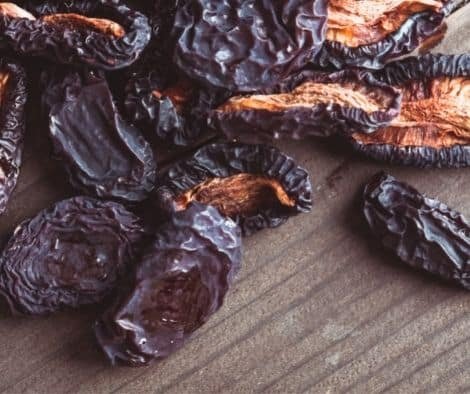




Dehydrating plums is a great way to get the most out of this nutrient-dense fruit. For the best results, always start with fresh plums—look for ones that are firm, fragrant, and have a vibrant color to ensure optimal ripeness and quality. Plum ripeness is best assessed by gently squeezing each plum to check for prime ripeness. Plums have been touted to have many health benefits, including a natural vitamin C and potassium source. This recipe article will walk you through how to dehydrate plums so that they can be enjoyed all year long! The dehydration process described here can also be used for other fruits such as apples, which are a popular choice for drying due to their texture and versatility.
If this is your first time dehydrating plums, don’t worry—this step-by-step course makes it easy! Follow these instructions to preserve your plums for later use.
Note: You can also dry whole plums by making a slit and removing the pit, but this will increase the drying time.
When it comes to drying plums, selecting the right variety makes all the difference in the final flavor and texture of your dried fruit. Prune plums—sometimes called Italian or European plums—are the top choice for making your own prunes at home. These plums are smaller and less juicy than other varieties, with a dense, sweet flesh that dries beautifully without becoming tough or leathery. Their freestone pits are easy to remove, making the preparation process much simpler. Other commonly used varieties for drying include ‘Italian’, ‘Brooks’, ‘Stanley’, and ‘Imperial Epineause’.
Prune plums are ideal for creating chewy, flavorful dried plums and are also perfect for recipes like fruit leather or as a base for other dried fruit snacks. While you can experiment with drying other fruits such as peaches, apricots, and pears, prune plums consistently deliver the best results thanks to their naturally sweet-tart flavor and smooth texture. Whether you’re looking to enjoy dried plums as a snack or incorporate them into your favorite recipes, starting with the right plum variety ensures a delicious, sweet treat every time.
You will know when there is no visible moisture on the fruit. Once the plum is cool, you can check if it folds easily in half. Another way you can check is by squeezing it to see if it does not stick to your hands.
Once your dried plums have cooled after the drying process, proper storage is key to preserving their delicious flavor and health benefits. To keep your dried plums fresh and packed with vitamins, transfer them to airtight containers like glass jars or sturdy freezer bags. Store these containers in a cool, dark place—such as a pantry or cupboard—where they’ll be protected from light and moisture.
Before sealing your dried plums away, double-check that they’re completely dry and free from any signs of moisture or mold. If you plan to enjoy your dried plums over several months, storing them in the freezer is a great way to extend their shelf life and maintain their chewy, pliable texture. Regularly inspect your stored dried plums to ensure they remain soft and not overly dry or sticky. With the right storage methods, you can enjoy the health benefits and sweet flavor of your homemade dried plums all year long.
You can consume them right out of the dehydrator once cool. They can also be used in trail mix or granola for a more festive touch during the holidays! If you’re interested in tasty trail mix ingredients, check out these best foods to dehydrate for snacks.
You can enjoy them as an easy-to-grab last-minute breakfast in place of toast before you head out to work, pack them with lunch for a light, filling midday snack, or have them as a sweet after-dinner treat.
Plum yogurt parfait: layer your favorite variety of yogurt with dehydrated plums and granola for a satisfying breakfast.
Dried plum crumble topping: add dried plums to oatmeal, cereal, pancakes, or desserts like brownies for an extra burst.
Not only are dehydrated plums (prunes) a delicious snack, but they’re also rich in beneficial nutrients. So whether you want to enjoy the fruit as-is or sprinkle them on salads and yogurt parfaits, there’s no denying how good these little fruits can be for us!
According to healthline.com, one ounce (28-gram) serving of prunes contains the following:
Plums and prunes are also rich in antioxidants which are beneficial to how your cells function. Additionally, dried plums can reduce inflammation, helping to prevent various diseases.
You can buy dehydrated fruit at most grocery stores, but it may not be the best quality. You can always purchase dry fruits online and have them shipped to you in a few days.
Amazon has a wide variety of dehydrated fruits to choose from, including plums.
Dried plums are a delicious, healthy snack that can be enjoyed whenever you want. The best part is they’re easy to make at home! If you have time on the weekend, give this recipe for plums a try and let me know how it goes in the comments below. I’m always happy to help answer any questions about dehydration using my experience with drying all sorts of foods. Send us a message if there’s anything else we can do to help – we love hearing from our readers!